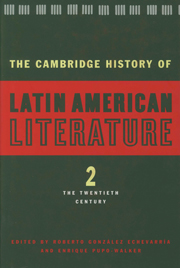Book contents
- Frontmatter
- Introduction to Volume 2
- 1 Modernist poetry
- 2 Modernist prose
- 3 The Vanguardia and its implications
- 4 The literature of Indigenismo
- 5 Afro-Hispanic American literature
- 6 The Criollista novel
- 7 The novel of the Mexican Revolution
- 8 The Spanish American novel from 1950 to 1975
- 9 The Spanish American novel: recent developments, 1975 to 1990
- 10 Spanish American poetry from 1922 to 1975
- 11 The modern essay in Spanish America
- 12 Literary criticism in Spanish America
- 13 The autobiographical narrative
- 14 The twentieth-century short story in Spanish America
- 15 Spanish American theatre in the twentieth century
- 16 Latin American (Hispanic Caribbean) literature written in the United States
- 17 Chicano literature
- Index
- Bibliographies
- References
4 - The literature of Indigenismo
Published online by Cambridge University Press: 28 March 2008
- Frontmatter
- Introduction to Volume 2
- 1 Modernist poetry
- 2 Modernist prose
- 3 The Vanguardia and its implications
- 4 The literature of Indigenismo
- 5 Afro-Hispanic American literature
- 6 The Criollista novel
- 7 The novel of the Mexican Revolution
- 8 The Spanish American novel from 1950 to 1975
- 9 The Spanish American novel: recent developments, 1975 to 1990
- 10 Spanish American poetry from 1922 to 1975
- 11 The modern essay in Spanish America
- 12 Literary criticism in Spanish America
- 13 The autobiographical narrative
- 14 The twentieth-century short story in Spanish America
- 15 Spanish American theatre in the twentieth century
- 16 Latin American (Hispanic Caribbean) literature written in the United States
- 17 Chicano literature
- Index
- Bibliographies
- References
Summary
The history of colonial and republican America is also – in its margins, footnotes, and backpages – the history of the Indian. Not of the Indian as he is but as white and mestizo writers from Alonso de Ercilla (1533–1594) to Ventura García Calderón (1886–1959) and José María Arguedas (1911–1969) have chosen to typecast, vilify or idealize him.
The inexorable modification of the first Americans begins with the Arcadian portrayal of Fray Bartolomé de las Casas (1474–1566), a fanciful notion that provides the germ for Rousseau’s noble savage two centuries later. This process of transfiguration is not the only feature that harnesses together the colonial perception with that of our contemporaries, however. Curious as it may seem, almost all of the elements that were to typify the literature of Indigenismo [Indigenism] in the 1840s are already in evidence in the chronicles of the Conquest and the literature of the early colonial period.
The blend of romantic idealization and social indictment favoured by Las Casas and El Inca Garcilaso (1539–1616), Alonso de Ercilla’s vision of warring braves and passionate heroines, the picturesque traditions and unprecedented myths portrayed in the work of Bernal Díaz del Castillo (1496?–1584?) and Bernardo de Balbuena (1568–1627) enter as one unit into the fiction of authors who, since Independence, had been avidly searching for colorful imagery to portray what they saw as the originality of America. And, since independence from Spain came at a time when the romantic movement held sway, a good many of the Indian protagonists during the first three quarters of the nineteenth century developed as exotic objects, faithful reflections of Chateaubriand’s and Walter Scott’s literary conceits.
- Type
- Chapter
- Information
- The Cambridge History of Latin American Literature , pp. 138 - 163Publisher: Cambridge University PressPrint publication year: 1996
References
- 11
- Cited by

